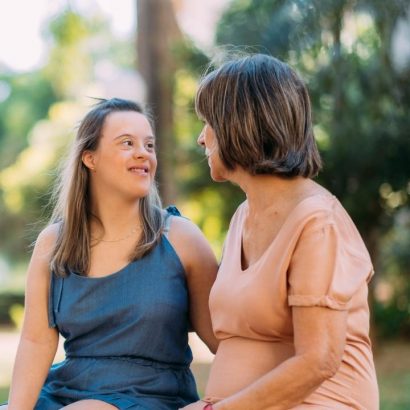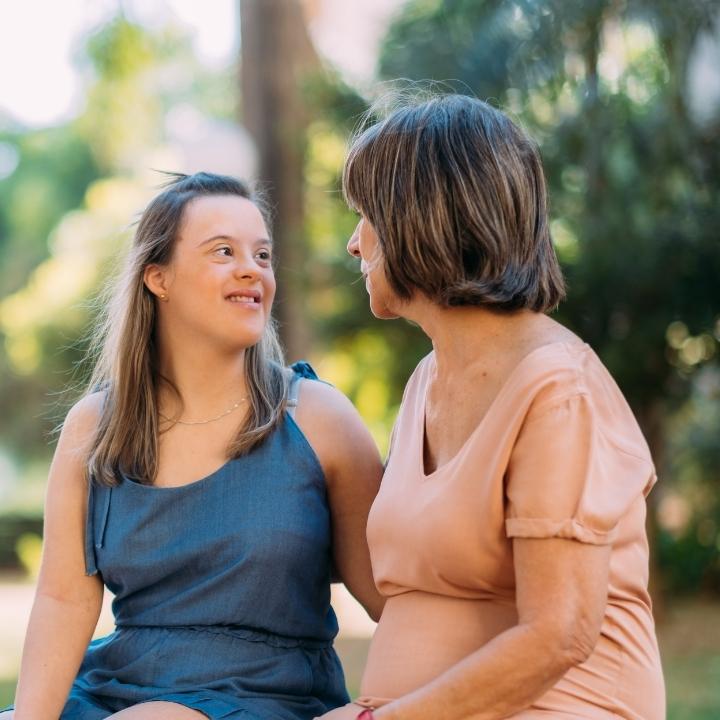In this guide:
Down syndrome explained
Down syndrome is a genetic disorder that occurs when a baby is born with an extra copy of chromosome 21.
The human body has trillions of cells, and within each cell is a thread-like structure made up of DNA, called a chromosome. Chromosomes are what determine how a baby’s body develops and functions during pregnancy and after birth.
Most people have 23 pairs of chromosomes in each of their cells (46 in total), but people with Down syndrome have 47 chromosomes in their cells, i.e. they have an extra chromosome 21. This extra copy changes how the baby’s body and brain develop, which may cause intellectual and learning disabilities as well as physical challenges for the person as they grow.
When thinking about Down syndrome, it’s important to remember that:
- Down syndrome is a genetic condition
- Down syndrome is not an illness or a disease
It is a lifelong condition with no cure - As a genetic condition that is caused randomly It cannot be prevented and no one is responsible for the extra chromosome developing
- Each person with Down syndrome is a unique individual with their own personality, passions, strengths and weaknesses, just like anyone else
- They also have their individual needs for support as they go through life.
What are the common signs or symptoms of Down syndrome?
While the word ‘symptom’ is sometimes used to talk about Down syndrome, it is not the appropriate term. It’s important to remember that Down syndrome is not an illness but a genetic condition. Instead, we talk about the characteristics and traits that may accompany the condition. Each individual with Down syndrome is unique and may have these characteristics to varying degrees – or not at all.
People with Down syndrome may experience some intellectual and developmental differences. These can include further challenges with learning, memory and problem solving. Developmental milestones, such as walking or speaking, may take longer to achieve.
Although people with Down syndrome may have different physical features, not everyone with Down syndrome looks ‘the same’. As a matter of fact, individuals with Down syndrome often share more features with their family members than with each other, just like anyone else.
Types of Down syndrome
Trisomy 21
- Trisomy 21 is the most common type of Down syndrome
- It occurs when an extra chromosome is found in all cells
- Trisomy 21 creates intellectual and physical differences.
Mosaic Down syndrome
- Mosaic Down syndrome occurs when only some cells have the extra chromosome, while others don’t
- Mosaic Down syndrome causes fewer characteristics of Down syndrome.
Translocation Down syndrome
- Translocation Down syndrome occurs when part of chromosome 21 breaks off and attaches to another chromosome
- Translocation Down syndrome can have a varying impact on intellectual and physical differences.
What causes Down syndrome?
No matter what type of Down syndrome a person may have, all people with Down syndrome have an extra chromosome 21 present in some or all of their cells. The extra genetic material alters typical development, leading to the characteristics of someone with Down syndrome.
Although we know how Down syndrome occurs, it’s not known as to why it occurs. According to Down Syndrome Australia, it’s caused by a random biological event at conception or shortly after. Typically, a person has two copies of each chromosome, including chromosome 21. However, in a baby with Down syndrome, there are three copies – a condition known as trisomy 21.
According to the National Institute of Child Health and Human Development, most cases of Down syndrome result from ‘a random error in cell division’ called nondisjunction. This occurs when chromosome pairs do not separate as expected during the formation of reproductive cells (sperm or egg). Usually each cell receives one chromosome from each pair. In nondisjunction, both chromosomes from one pair move into one cell – leaving the other without any chromosomes from that pair.
It is important to emphasise that no behavioural activity or environmental factor has been found to be linked to the development of Down syndrome. Extensive research shows this chromosomal error is random and cannot be prevented. This knowledge increases awareness and debunks myths surrounding the condition.
Support for people with Down syndrome
Through Mable, children and adults with Down syndrome can access a variety of support options to help them to achieve their goals and lead fulfilling and enjoyable lives. Independent support workers on Mable can offer support with social engagement, learning a new skill, capacity building to become more independent, supporting a person in their place of employment, and much more.
Support for children with Down syndrome
For children with Down syndrome, support workers can assist in areas such as:
- Play and physical health: Engaging children in play to promote physical health and development.
- Learning and communication: Activities like reading, writing and improving fine motor skills to complement school education.
- Skill building: Support workers with specific skills can help children learn skills like playing an instrument, dancing or sign language.
- Daily routines: Establishing routines for getting ready, traveling to school, mealtimes and playtime to provide structure and stability.
- Health monitoring: Assistance with regular health check-ups, including hearing, eyesight and general medical appointments.
- Respite care: Offering short-term care for parents to take a break while ensuring the participant’s needs are met.
- Independence and social skills: Building confidence and encouraging social participation through structured activities.
Support for adults with Down syndrome
For adults with Down syndrome, support workers can assist in areas such as:
- Daily living tasks: Assistance with cooking, grocery shopping, cleaning, laundry and personal care.
- Education and skill development: Support for pursuing higher education, certifications, or learning new hobbies like photography, cooking or playing an instrument.
- Financial management: Helping with budgeting, bill payments and banking.
- Independent living: Transitioning to independent living by connecting individuals with accommodation options and assisting with necessary documentation and interviews.
- Employment and volunteering: Assistance with finding, securing and maintaining employment or volunteer opportunities.
- Social engagement: Accompanying individuals to social events, outings or trips to encourage interaction and enjoyment.
- Physical and mental well-being: Supporting regular exercise routines or recreational activities like painting or fishing to promote overall wellness.
Mable’s platform allows families and individuals to select support workers with specific skills or expertise that align with their unique needs. By creating a team of support workers, participants can receive assistance in multiple areas of life, ensuring a well-rounded approach to care.
Natalie says the support her son Max receives via Mable has made her feel “like I’m in control again”. And Mable client Paige, who lives with Down syndrome, teaches dance classes to people with disabilities.
Children under the age of seven can receive NDIS funding through Early Childhood Early Intervention. Those with Down syndrome who are above seven years of age have to meet eligibility requirements for NDIS funding. If you’re approved for NDIS funding, you can use it to find support workers through Mable. Even if you’re not eligible for NDIS funding, you can connect with support workers via Mable and choose to pay privately.
World Down Syndrome Day
World Down Syndrome Day is celebrated every 21st of March. The date was chosen to show the uniqueness of the triplication of the 21st chromosome – which creates Down Syndrome.
To celebrate World Down Syndrome Day, there are various events and initiatives in Australia to raise awareness and promote inclusion for individuals with Down syndrome. One popular activity is the ‘Lots of Socks’ campaign, where participants wear brightly coloured or mismatched socks to spark conversations about Down syndrome. This visual approach encourages people to ask questions and learn more about the condition.
Raising awareness through these events helps the public to understand what Down syndrome is and what causes it. By participating in World Down Syndrome Day activities, individuals and communities encourage better acceptance and support for people with Down syndrome – promoting their rights, inclusion and well-being.
For those interested in getting involved, Down Syndrome Australia provides resources and information on national events and how to participate.
Frequently asked questions
How common is Down syndrome?
From 2016 to 2020, approximately 265 babies with Down syndrome were born annually in Australia, equating to about 1 in every 1,158 births.
Can Down syndrome be treated or cured?
According to Down Syndrome Australia, Down syndrome is not a disease or an illness but a genetic condition that occurs from conception. It is created by the presence of an extra copy of chromosome 21, a condition called trisomy 21. Because this additional genetic material is present in every cell of the body and determined at conception, it cannot be cured or reversed.
Early access to therapies such as speech therapy, physiotherapy, and occupational therapy, along with educational and social programs, can help individuals with Down syndrome reach their full potential and lead fulfilling lives.
How can adults with Down Syndrome be supported?
Independent living for adults with Down syndrome often involves tailored levels of support – depending on their individual needs. There are services available to support adults with Down syndrome such as employment support to find a job or supported independent living arrangements.
Life for adults with Down syndrome can involve work and earning an income, enjoying positive relationships, and parenthood.
Can you get Down syndrome as an adult?
No, Down syndrome is a lifelong genetic disorder that occurs at conception. It is not possible to develop Down syndrome later in life.
The information provided in this article is general information only, is based on current information at the date of publication and is not providing you with medical advice. In addition to considering the information shared in this article, Mable encourages you to seek your own independent medical advice about Down syndrome and its impacts on a particular individual.

